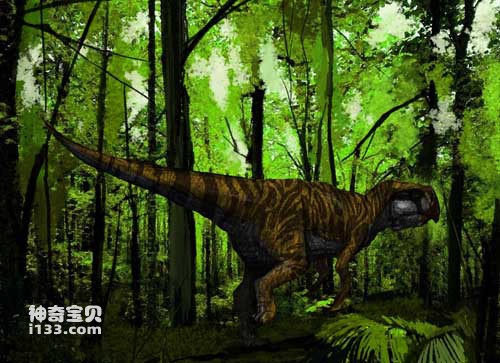Psittacosaurus is 1.8 meters long and about 1 meter high. It is a very cute small dinosaur. It is named after having a parrot beak. This dinosaur was distributed in a vast geographical space, mainly concentrated in the Early Cretaceous from southern Siberia to Mongolia and northern China. A large number of Psittacosaurus fossils have been discovered, and many specimens are quite complete. Among them, the Psittacosaurus fossil preserved in the China Dinosaur Park is a typical representative. It has a well-proportioned body shape, a thick head, and well-developed forelimbs. The hind limbs are strong and the body is upright. The ground and background are all yellow sand, which looks very vicissitudes of life against the soft yellow light.
The first Psittacosaurus discovered was in the Gobi Desert in southern Mongolia. In 1922, the Third Central Asia Expedition led by Andrews of the Museum of Natural History in New York collected many Psittacosaurus and Psittacosaurus eggs during the expedition. Dinosaurs excavated from this formation often appear together with pterosaurs, and are generally considered to be from the Early Cretaceous, forming a unique fauna in Asia - the Psittacosaurus-Pterosaur fauna.
When we introduce Psittacosaurus, we must start with its "beak". After studying the skull of Psittacosaurus in the dinosaur park, we found that its upper and lower jaws had 7 to 9 trilobate cheek teeth on each side, and the teeth were smooth in texture. The most eye-catching thing is its huge horny beak. Its shape and function are very similar to that of a parrot, hence its name. The giant beak helps it bite off and chop plant stems and even nuts.
The huge bite force of the giant beak is beyond the imagination of paleontologists. Let's refer to the modern reptile-the eagle-billed turtle. The eagle-billed turtle is a member of the ratite family, mainly living in Southeast Asia. Its head cannot retract its carapace, its mouth is made of hard horn, and its upper jaw is pointed and curved, much like the giant beak of a Psittacosaurus. The bite of the eagle-billed turtle is so powerful that a fossil of a mammal, a reptile, was discovered in the Jehol Biota in western Liaoning, China. Surprisingly, a reptile was found in the stomach of this animal. The discovery of the skeleton of a juvenile Psittacosaurus overturned the image of weak Mesozoic mammals, and also proved that the environment in which Psittacosaurus lived was full of dangers.

Chinese name: Psittacosaurus
Latin name: Psittacosaurus
Age of survival: Early Cretaceous
Fossil origin: China, Mongolia, Siberia, Thailand
Physical characteristics: 1.8 meters long
Diet: plants
Species: Ceratopsian
Definition: parrot-billed lizard
animal tags: Psittacosaurus
We created this article in conjunction with AI technology, then made sure it was fact-checked and edited by a Animals Top editor.